

The Peking - Kalgan Railway
The first line to be financed, built, and operated solely by celestial effort
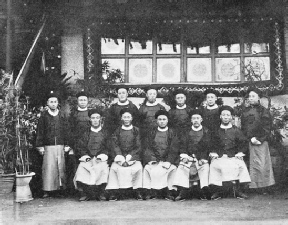
THE STAFF OF CHINESE OFFICIALS WHO BUILT THE PEKING-
CHINA is considered to offer one of the finest territories for railway conquest, and in consummating this end no effort is being spared by the various Powers. British, American, French, German, Belgian, and Japanese interests consider the Land of the Dragon as an ideal centre for the pursuit of their activities, and the varied undertakings have stirred international jealousies to a supreme degree.
But to the British alone is due the glory of having introduced Stephenson’s revolutionary invention into the land of the Celestials, though it proved by no means a simple or easy task. The Chinese, with their characteristic contempt for things occidental, did not view the steelway with enthusiasm. Every conceivable objection was raised, and when at last Messrs. Jardine, Matheson and Company, owing to their intimate commercial relations, suggested the idea, they met with an opposition which startled even them, notwithstanding the fact that they were pretty familiar with the ways of the “heathen Chinee”. Some time elapsed before sanction was extended for the construction of a short railway about 20 miles or so in length in the south.
The laying of the metals did not proceed smoothly by any means. Millions of spirits were threatened with disturbance, and it was by no means an easy matter to plot a line which should pay every required respect to native superstition. But at last the job was finished and the trains commenced to run. The promoters of the enterprise thought that at last they had worn down Chinese antagonism, and that the benefits of the railway soon would become appreciated. But they were speedily disillusioned. One day a coolie was run over and killed. British opinion leans towards the theory that this untimely death was courted purposely, just to bring the newfangled notion into national disrepute. Whether it was an accident or a suicide the result achieved the natively desired end. The inhabitants of the district rose up en masse; their fury was such that they tore up the line and threw the rails and sleepers into the sea. Some scraps were saved and were shipped to another Eastern territory where the railway was not regarded with such hostility. The Imperial Government, in order to appease the wrath of the populace, decreed that nothing pertaining to the nature of a railway should be laid in any part of the kingdom from that time forward, and every concession which had been conceded was rescinded there and then.
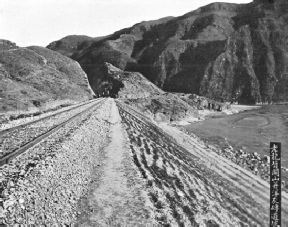
A TYPICAL STRETCH OF TRACK AMONG THE MOUNTAINS ON THE PEKING-
This drastic action came as a severe blow to the interests which had fathered the introduction of the railway into China. But their disappointment was trivial in comparison with that of Mr. Kinder, the present great grand old British “Railway King” of China, now controlling the Northern Imperial system. At the time he was resident engineer at the Kai Ping coal fields, in the neighbourhood of Tang-
But Mr. Kinder had no use for animals when steam traction might be employed more profitably. He suggested to Tong King Sing, the guiding spirit of the mining enterprise, that a steam locomotive should be used. This enlightened official agreed with the proposal, but, aware of the antagonism to the locomotive, urged that they should proceed warily. He suggested that possibly an engine might be built on the spot, but Mr. Kinder, reviewing the facilities at his disposal, was somewhat sceptical of success. Tong King Sing, however, maintained that this would be the better course to pursue, as no alarm would be raised; it might be possible to introduce the engine unawares and to run it, thereby wearing down the existing prejudice unconsciously. Mr. Kinder realised the wisdom of the argument and agreed to do the best he could. He widened the tramway to the standard gauge of 4 feet 7½ inches, and then cast among the various scrap-
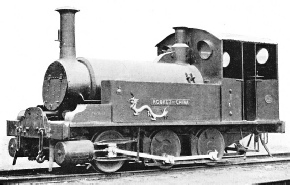
THE “ROCKET OF CHINA”. The first locomotive built in China by Mr. Kinder, C.M.G., from odds and ends rescued from scrap-
But news reached the Imperial Government concerning the Britisher’s ingenuity, and it summarily ordered the work to be stopped. The official intimation was disregarded. The Government became incensed at this flagrant flouting of authority, and announced that it would dispatch a Commission to the mines to investigate the truth of the reports upon the spot. If an engine were found dire penalties would be meted out. Mr. Kinder and his colleagues received wind of the movement, and recognising the serious situation with which they were confronted, made arrangements accordingly. A huge pit was dug, and into this the offending locomotive was dropped and carefully buried. When the Government Commission reached the mines no trace of the reputed locomotive was to be seen; the cars were being hauled by mules in the usual manner. Once more rumour had proved to be a lying jade, and the Commission departed homewards in chagrin, somewhat incensed against those who had spread the alarming news.
At that time Li Hung Chang was an unequivocal antagonist to railways, and forthwith the influential mining officials devoted their energies to winning him to the new order of things. Their first approaches were rebuffed, but they clung to their task, and at last succeeded in impressing His Excellency with the advantages of steam traction. At this juncture it was deemed safe to resuscitate the “Rocket”, so the grave was reopened, the engine exhumed, overhauled, and put to work once more. Then the wily mine owners suggested that Li Hung Chang should come down and see the engine at work, just to appreciate what it could do. He did, and was convinced, though he kept his opinion to himself, but ever after became a firm adherent of railway development. Gradually the length of line was extended, and although the enterprise experienced numerous vicissitudes, Mr. Kinder stuck to his work and finally won out. The crowning stroke came when the Government desired to improve facilities for moving the troops from point to point quickly. “Why, it can only be achieved in one way,” remarked certain Court officials interested in the idea; “that is by railway. If the Tai Ping coal road is extended it will be possible to move the soldiers from the coast to the capital in a matter of a few hours instead of days.” The Government, ever careful of its own safety, appreciated the argument and sanctioned the extension.
Some thirty years have passed since Mr. Kinder, by his striking display of tenacity of purpose and enterprise, established the utility of the locomotive, and in the meantime great changes have been wrought. Powerful financial interests of all nationalities have over-
In this forward move the Chinese have been content to assume the role of apathetic spectators. They have left the grid-
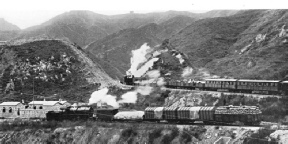
WORKING TRAFFIC OVER THE SUMMIT ZIGZAG in the Nankow Pass.
But some six or seven years ago the invaders received a rude shock. A suggestion was made that a railway should be built from Peking to Kalgan on the famous caravan route to Russia. Seeing that the line was to traverse some of the most difficult country in the Empire, it is not surprising that in the beginning it was suggested that the enterprise should be handed over to outside interests. But the progressive members of the country took a firm stand. We can build this line ourselves, and we can find the money to defray the cost, so we will do it. The foreign engineers scouted the suggestion, and laughed at Chinese ambitions. But the authorities were not dismayed. The decree ran that the line should be financed, engineered, and built by the Chinese.
Success depended upon the discovery of an engineer competent to carry out the scheme. This did not prove a difficult task. Some years previously, in 1880, a number of Chinese students had been sent to the United States to receive university training. Among these was Jeme Tien Yow. He alone took up civil engineering, especially in its relation to railway construction. He graduated at Yale in 1883, and then came to England, where he studied in a technical school for several years. Returning home, he entered the Imperial Railways of Northern China under Mr. Kinder, the builder of the “Rocket”, where he became familiarised with railway problems upon the spot. His advance was rapid, and he attained one of the highest positions in the service.
When the Peking-
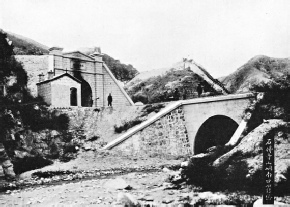
A TUNNEL AND CULVERT ON THE PEKING-
In inaugurating the building department no white labour of whatever description was employed. Chinese were requisitioned, from the coolies for the camel transport to the highest positions, and railway building in China never proceeded so smoothly as was the case upon the Peking-
The first 32 miles out of the Imperial capital runs over a drab, uninteresting plain, lifeless except for the pack trains of mules, donkeys, and camels, laden with furs brought from Mongolia for the Peking market. Yet, although the country is tolerably flat, great difficulties were encountered. The first wet season following the completion of this section brought the heaviest flood known for forty years, which submerged the country and washed out the railway embankment to such an extent that some £32,000 had to be expended to repair the damage. In order to protect the steel highway against a repetition of such a disaster heavy retaining walls were built, while numerous massive concrete culverts were introduced to carry off the surplus waters. On this Luitsin division, as it is called, there are no fewer than 21 bridges and 17 culverts. All are of a permanent character, wrought in steel or concrete. The largest bridge is approximately 300 feet in length and comprises five spans, each of 30 feet, and one of 110 feet. The whole of the steel for this structure, with the exception of the long span, which was built in England, was prepared in Chinese shops, and the same applies to all other metallic structures upon the line.
The heaviest and most trying piece of work encountered in the whole 130 miles was the negotiation of the Nankow Pass, through which the main caravan road wends its northward way through the Great Wall. The mountains tower up abruptly from the plains, and it became necessary to rise 1,800 feet in 10 miles. His Excellency Jeme Tien Yow, having been drilled in the modern railway building school, endeavoured to plot a line conforming with present trunk line conditions, free from heavy banks and sharp curvatures.
Finally a feasible route was obtained showing a minimum curvature of 1 in 600. Heavy tunnelling was found unavoidable. The alignment for the most part follows the contour of the mountain sides, involving heavy side-
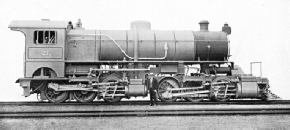
A BRITISH-
Four tunnels were found to be unavoidable upon this section of 13 miles, their respective lengths being 1,200, 150, 450, and 3,580 feet. The first tunnel, near the foot of the Pass, traverses limestone, and was driven in six months, but the three other tunnels extend through solid granite. The last, which leads to the summit of the Pass, is the biggest and longest work of its kind in China, while it burrows 200 feet beneath the Great Wall. Despite the unusual magnitude of this task, the tunnel was completed within a year, and, in common with the other works of this class, is lined throughout with concrete, the portals being finished and faced in the same material. By the time the summit of the Pass was gained 640,000 cubic yards of spoil, half of which was solid rock, had been excavated, while the embankments required some 275,000 cubic yards of material. To complete these 10 miles of difficult track only £37,500 was expended upon labour, which affords some idea of how cheaply railways of the most substantial character can be built by the Chinese.
As the Nankow Pass section of the railway is the most trying from the operating point of view, owing to its grade and curvature, three special engines have been acquired to move all trains over this division. They are articulated compound Mallets of the 0-
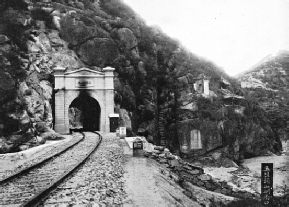
ONE OF THE SHORT TUNNELS in the Nankow Pass.
These engines are stationed at Nankow, at the foot of the Pass, and they lift the trains to Ching Lung Chiao, a distance of 13 miles; the average train load is about 180 tons, exclusive of the locomotive, and they overcome the Pass in about two hours, a smart performance, considering the heavy character of the road. In order to obviate the possibility of the train breaking away, the engine pushes the load from the bottom of the Pass to the apex of the summit zigzag, where a smaller locomotive picks up the train and hauls it on to Kalgan.
Emerging from the mountains, the railway enters a lofty plateau where little difficulties of a technical nature were encountered beyond heavy bridging and providing numerous concrete culverts to cope with the flood waters. The most important piece of work on the 38 miles of this section is the bridge, 1,000 feet in length, having ten 100-
From the constructional point of view the Peking-
The rolling stock is of the most up-
The line has proved a success from the financial point of view, and its extension into Chinese Turkestan, so as to link the outermost western parts of the Empire with the seat of Government, is being contemplated. The cost of the undertaking was defrayed completely out of the surplus earnings of the Government lines in North China.
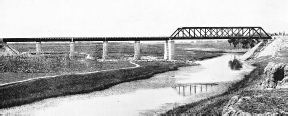 A TYPICAL BRIDGE on the Peking-
A TYPICAL BRIDGE on the Peking-
You can read more on
And
And
“Travelling by Train in China”
on this website.